You might think Chicken Kiev is just another delicious dish, but have you ever considered its deep cultural roots and historical journey? With origins steeped in Ukrainian tradition, this seemingly simple entrée rose to prominence in the mid-20th century Soviet Union, symbolizing both luxury and resilience. The blend of French culinary techniques and Eastern European practicality in its preparation is intriguing, but what really sets Chicken Kiev apart is its role in family gatherings and celebrations. Curious about how this dish became an emblem of shared heritage and culinary artistry? Let’s explore its enchanting evolution and lasting cultural significance.
Origins of Chicken Kiev
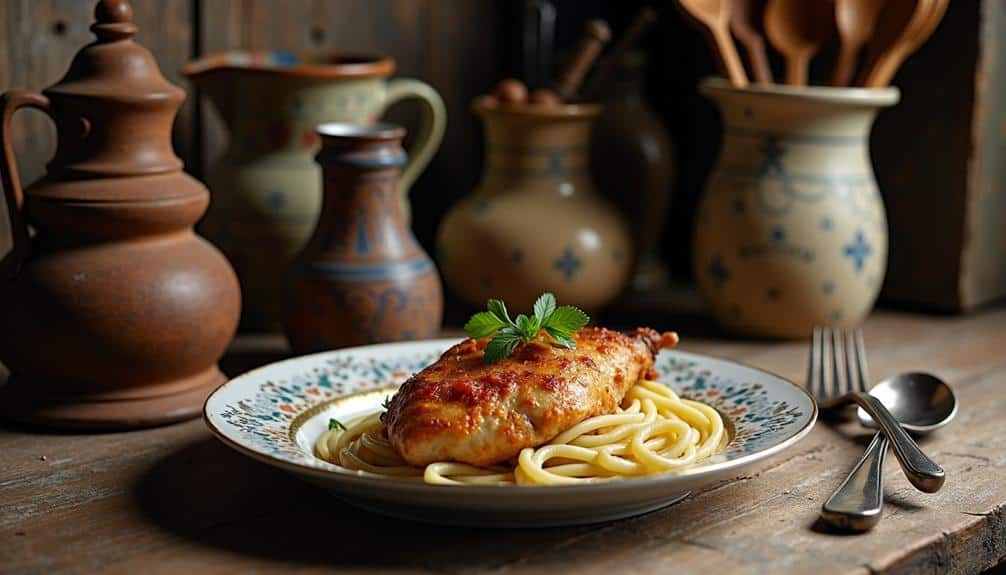
Chicken Kiev, a dish that has tantalized taste buds for generations, boasts a history as rich and complex as its flavor profile. You might be fascinated to learn that its origins are shrouded in culinary myths and debates. While many associate it with Russia, this delicious creation actually has strong Ukrainian roots. The name itself suggests a connection to the Ukrainian capital, Kyiv, highlighting its deep cultural significance in the region.
Some stories claim it was invented by French chefs working in the Russian aristocracy’s kitchens, but don’t be misled. The dish likely evolved locally, drawing on Ukraine’s rich culinary traditions. It’s not just a simple breaded chicken breast; it’s a reflection of the region’s love for hearty, flavorful food.
Understanding the origins of Chicken Kiev involves peeling back layers of history and culinary evolution. The dish became popular in mid-20th century Soviet Union, further embedding it in the fabric of Eastern European cuisine.
Yet, the heart of Chicken Kiev unmistakably beats with Ukrainian heritage, debunking many of the myths that cloud its true beginnings. Now, when you savor this dish, you appreciate its rich, storied past.
French Culinary Influence
French culinary influence has undeniably left an indelible mark on the development of Chicken Kiev. When French chefs were invited to Russian courts in the 18th century, they brought with them a repertoire of sophisticated techniques that transformed Russian cuisine.
You’ll find that the meticulous method of encasing herbed butter within chicken breast reflects classic French techniques like “en papillote” and “sous vide”, which emphasize moisture retention and flavor infusion.
By adopting these techniques, Russian chefs created a culinary fusion that elevated Chicken Kiev from a simple dish to a gastronomic delight. The breading process, another hallmark of French cuisine, adds a crispy texture that contrasts beautifully with the succulent chicken and melting butter inside.
This fusion not only enhanced the dish’s flavor but also its visual appeal, making it a favorite in both aristocratic and popular circles.
In essence, the French influence didn’t just modify Chicken Kiev; it redefined it. This culinary fusion brought a level of sophistication and complexity that you’ll appreciate every time you cut into the crispy exterior and discover the rich, buttery core.
Understanding this influence helps you see Chicken Kiev as a reflection of the power of cross-cultural culinary evolution.
Evolution Over Centuries
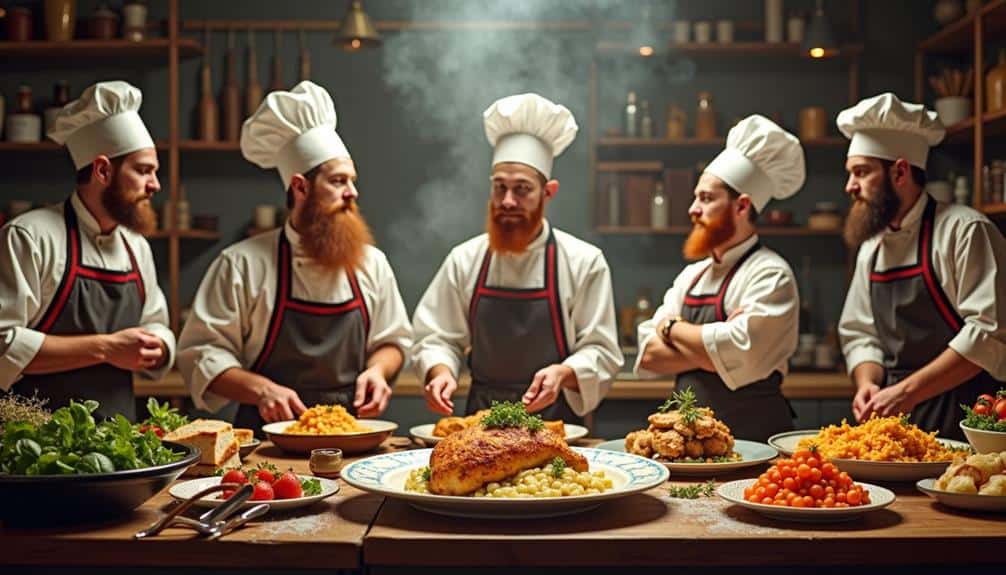
Over the centuries, Chicken Kiev has continually evolved, shaped by various cultural and historical influences.
Initially, it’s believed to have roots in French cuisine, specifically with culinary techniques brought to Russia by French chefs in the 18th century. These chefs introduced complex methods such as stuffing meat with butter, which was relatively new to Russian palates at the time.
As time progressed, historical recipes of Chicken Kiev began to reflect the blending of French sophistication with Russian practicality. The dish, originally known as “Côtelettes de Volaille,” transformed to a more accessible form for the Russian aristocracy and eventually the general populace.
In the 19th century, during the rise of the Russian Empire, the recipe was simplified without losing its essence—retaining the signature butter core that burst with flavor upon the first bite.
Post-World War II, the dish gained international fame, becoming a symbol of Soviet cuisine. It was during this period that the recipe underwent further refinement, adapting to the availability of ingredients and local tastes.
The evolution of Chicken Kiev showcases a fascinating journey where culinary techniques and historical recipes intertwine, creating a dish that remains cherished across generations.
Chicken Kiev Ingredients and Preparation
When preparing Chicken Kiev, you’ll need a keen eye for detail and a bit of patience to get everything just right. Start by sourcing the freshest ingredients. High-quality, boneless chicken breasts are indispensable; they provide the canvas for this dish. You’ll also need butter, garlic, fresh parsley, lemon juice, and breadcrumbs. Each component plays a significant role in achieving the perfect balance of flavors and textures.
Chicken Kiev Ingredients:
– 2 boneless chicken breasts
– 4 tablespoons butter, softened
– 2 cloves of garlic
– 1 tablespoon fresh parsley, chopped
– Salt and pepper, to taste
– All-purpose flour for dredging
– 2 eggs, beaten
– Bread crumbs for coating
– Vegetable oil, for frying
Preparation:
1. Preheat oven to 350°F (175°C).
2. Butterfly the chicken breasts and gently pound to an even thickness.
3. In a bowl, combine softened butter, minced garlic, parsley, salt, and pepper.
4. Spread the butter mixture evenly on each chicken breast.
5. Fold the chicken breasts in half, enclosing the butter mixture, and secure with toothpicks.
6. Dredge each chicken breast in flour, then dip into beaten eggs.
7. Coat with bread crumbs, pressing firmly to adhere.
8. Heat oil in a skillet and fry the chicken until golden on each side.
9. Transfer the chicken to a baking dish and bake for about 15-20 minutes, until cooked through.
10. Remove toothpicks before serving.
Preparation techniques demand precision. First, make the herbed butter by mixing softened butter with minced garlic, finely chopped parsley, and a splash of lemon juice. Shape this mixture into a log and chill it until firm.
Next, carefully butterfly the chicken breasts and flatten them with a meat mallet. Place a portion of the chilled butter in the center of each breast, then fold and secure them tightly to prevent the butter from leaking during cooking.
Dip the stuffed chicken in flour, then beaten eggs, and finally coat it with breadcrumbs. Ensuring an even coating is essential for a crispy exterior. Fry the chicken until golden brown, then finish cooking in the oven to guarantee the meat is thoroughly cooked while the herbed butter melts perfectly inside.
Regional Variations
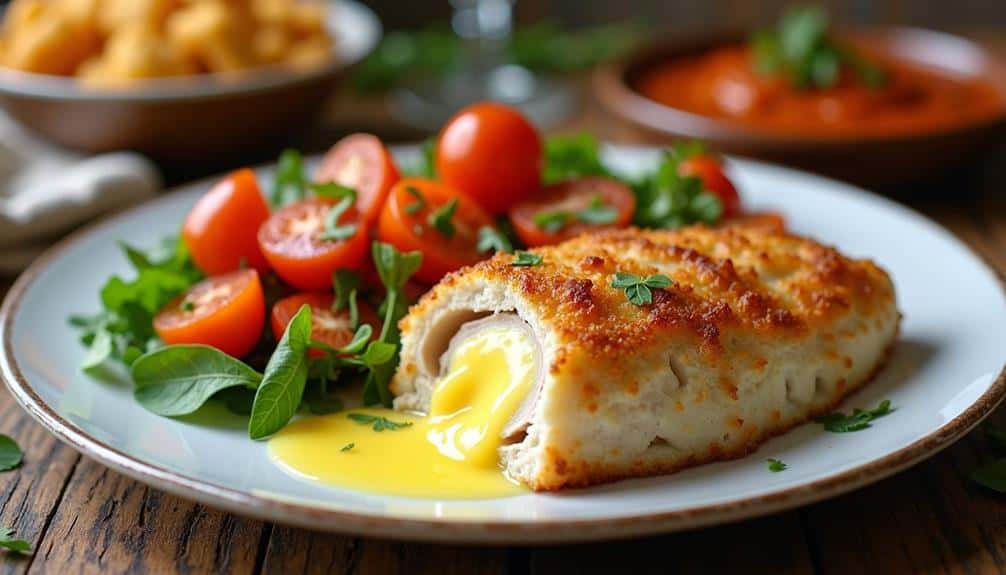
Regional variations of Chicken Kiev add a fascinating layer of diversity to this classic dish. As you explore the Kiev variations, you’ll notice that different regions have put their unique spin on the recipe, reflecting local tastes and available ingredients.
For instance, in Ukraine, where the dish is believed to have originated, you’ll often find a simple yet flavorful version with dill and parsley butter. This regional adaptation highlights the fresh herbs that are abundant in Ukrainian cuisine.
In contrast, Russian versions might incorporate more complex butter fillings, sometimes infused with garlic or mustard, giving the dish a richer and more robust flavor profile.
Then there’s the Polish take, known as “kotlet de volaille,” which often includes mushrooms or cheese in the filling, adding an extra layer of texture and taste.
As you investigate deeper into these adaptations, you’ll see how each variation not only enhances the dish but also tells a story of the region’s culinary history and preferences.
These Kiev variations are more than just modifications; they’re a demonstration of how Chicken Kiev has been embraced and transformed by different cultures, making it a truly versatile and beloved dish.
Chicken Kiev in Soviet Era
As you appreciate the diverse regional takes on Chicken Kiev, it’s intriguing to contemplate how this dish evolved during the Soviet era. During this time, Soviet cuisine often emphasized simplicity and uniformity, reflecting the broader socio-political agenda.
Chicken Kiev, however, maintained its status as a luxurious dish, symbolizing a bridge between traditional Russian culinary arts and the Soviet regime’s effort to promote a unified national identity.
The Soviet government utilized culinary propaganda to shape public perception, presenting Chicken Kiev as an emblem of Soviet prosperity. Despite economic hardships, Chicken Kiev was often featured in state-run restaurants and diplomatic banquets, showcasing the regime’s ability to provide for its people.
In this situation, the dish became a tool to convey the message of abundance and sophistication, aligning with the broader narrative of Soviet success.
During this era, the preparation of Chicken Kiev was streamlined to guarantee consistency across the Soviet Union. Standardized recipes circulated, ensuring that the dish remained recognizable and accessible.
This uniformity helped reinforce the idea of a cohesive Soviet identity, making Chicken Kiev not just a meal, but a symbol of cultural unity amidst the diverse Soviet landscape.
Modern Day Popularity
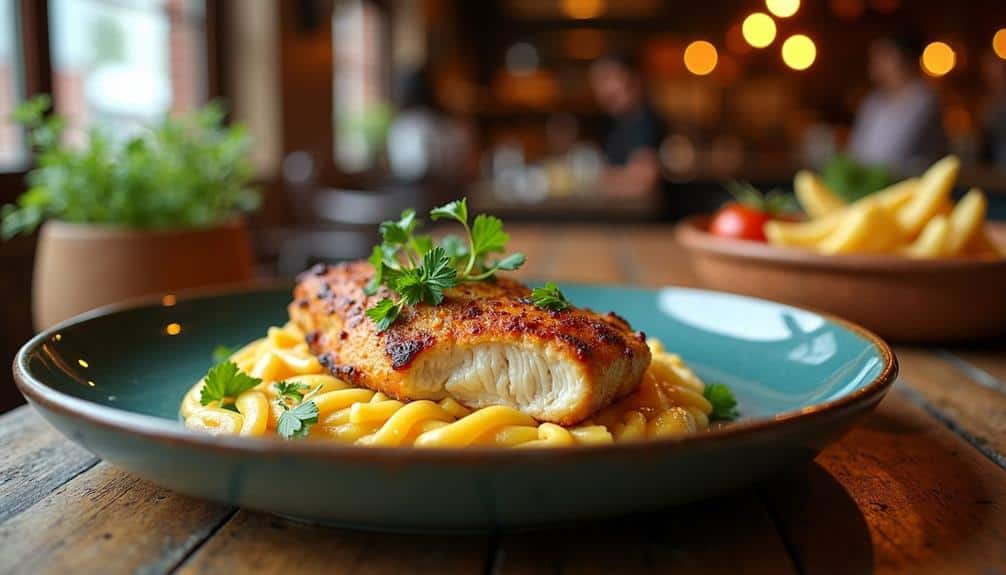
Chicken Kiev has seen a remarkable resurgence in modern times, enchanting food enthusiasts worldwide with its rich history and delectable taste. You’ll find this classic dish making a grand comeback in various culinary landscapes, transcending its Soviet-era roots and establishing a global influence.
Its appeal lies in the perfect blend of crispy breading and the succulent, garlic-herb butter filling, a combination that speaks to both traditional and contemporary tastes.
In today’s culinary world, Chicken Kiev exemplifies culinary fusion. Chefs are reimagining the dish by incorporating local ingredients and innovative techniques. You might encounter Chicken Kiev stuffed with truffle butter in upscale New York restaurants or infused with Asian spices in trendy Tokyo eateries.
This adaptability showcases not only the dish’s versatility but also its ability to evolve while retaining its core essence.
Moreover, the internet and social media have played pivotal roles in its revival. Food bloggers and influencers post recipes and cooking tutorials, making it accessible to home cooks enthusiastic to recreate this iconic dish.
As a result, Chicken Kiev has secured its place in modern cuisine, celebrated for its ability to bridge historical culinary traditions with contemporary gastronomic trends.
Cultural Symbolism
Over the decades, Chicken Kiev has transformed into more than just a beloved dish; it’s become a symbol of cultural identity and historical resilience. This dish, with its roots deeply embedded in Eastern European traditions, reflects the ingenuity and adaptability of its people.
The meticulous cooking techniques involved—such as carefully pounding the chicken, wrapping it around a rich herb butter, and then breading and frying it to perfection—demonstrate a deep appreciation for culinary craftsmanship.
You’ll find that Chicken Kiev often serves as a centerpiece at family gatherings, embodying a sense of unity and shared heritage. It’s not just the taste that matters, but the process of making it, which often involves multiple generations in the kitchen. This communal activity fosters a sense of belonging and continuity, connecting the past with the present.
Moreover, the dish’s enduring popularity through various historical upheavals underscores its role as a culinary anchor. Even during times of scarcity, families would endeavor to recreate Chicken Kiev, symbolizing hope and resilience.
Consequently, Chicken Kiev is more than just a meal; it’s a cultural artifact that encapsulates the spirit and fortitude of its people.
Celebratory Occasions
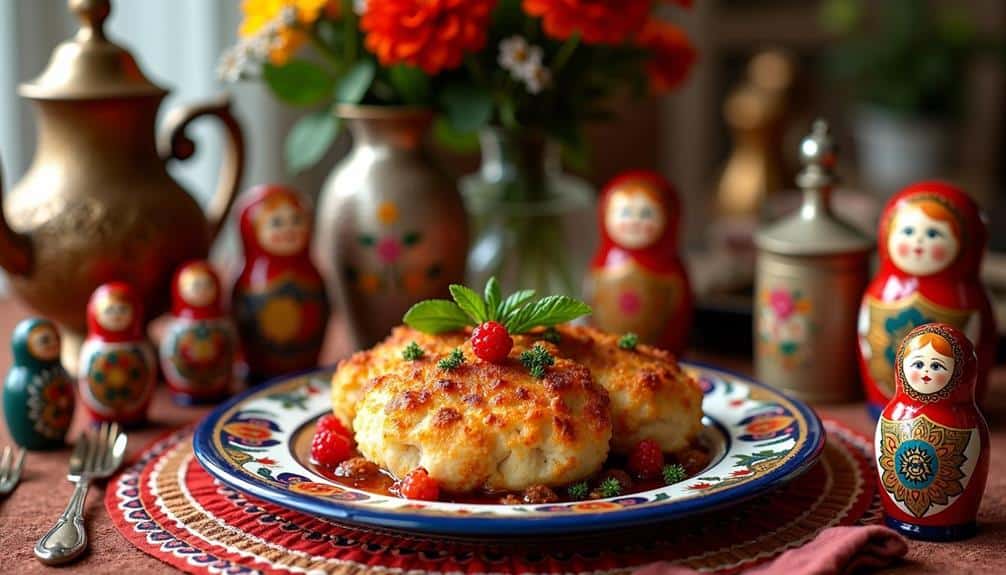
Often reserved for life’s grandest moments, Chicken Kiev shines as a star attraction during celebratory occasions. You’ll find it gracing tables at wedding feasts, where its rich flavors and elegant presentation add a touch of sophistication. The dish’s preparation, which involves a chicken breast filled with herbed butter, breaded, and fried to golden perfection, symbolizes meticulous care and culinary artistry.
At festive gatherings, Chicken Kiev becomes a centerpiece that brings people together. Its tantalizing aroma and the theatrical burst of melted butter when sliced open create an experience that’s both visually and gastronomically delightful. This isn’t just about eating; it’s about sharing a moment.
When you serve Chicken Kiev at a celebration, you’re not merely offering a meal; you’re presenting a piece of tradition that has been cherished for generations.
In the context of Russian culture, choosing Chicken Kiev for significant events underscores a respect for heritage and an appreciation for quality. The dish’s ability to elevate any occasion with its sumptuous taste and elegant appearance makes it a natural choice for those times when you want to create lasting memories.
Conclusion
You’ve seen how Chicken Kiev, rooted in Ukrainian traditions and touched by French culinary finesse, has evolved over centuries to become a symbol of cultural resilience. Its rich flavors and meticulous preparation make it a standout dish at weddings and family gatherings. Today, it bridges historical and modern culinary practices, showcasing regional variations and enduring popularity. Chicken Kiev isn’t just a meal; it’s a reflection of shared heritage and the ever-evolving art of cuisine.




